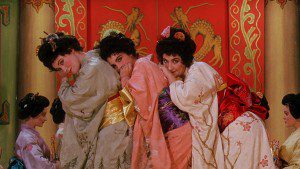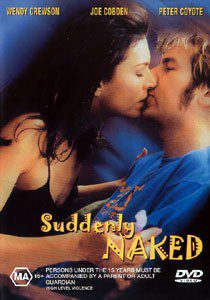 Well, here’s a how-de-do. British director Mike Leigh is well-known for his working-class dramas, such as Naked and Secrets and Lies, and for his uniquely improvisational approach to making them, whereby he and his actors take a premise and follow their characters’ impulses wherever they may lead. But in Topsy-Turvy, Leigh applies his technique to a true story, and of all things, it’s a richly-detailed costume drama about Gilbert and Sullivan.
Well, here’s a how-de-do. British director Mike Leigh is well-known for his working-class dramas, such as Naked and Secrets and Lies, and for his uniquely improvisational approach to making them, whereby he and his actors take a premise and follow their characters’ impulses wherever they may lead. But in Topsy-Turvy, Leigh applies his technique to a true story, and of all things, it’s a richly-detailed costume drama about Gilbert and Sullivan.
Still, who better to take us behind the scenes of London theatre than Leigh, who has directed live theatre himself? Topsy-Turvy begins in 1884 with the disappointing debut of Princess Ida, one of Gilbert and Sullivan’s less successful musicals; even Gilbert’s dentist complains that it isn’t up to snuff. It then follows the composers through a period of intense creative differences, followed by the creation, rehearsal, and performance of The Mikado, now widely regarded as their greatest production, a year later.
First, the creative differences. Arthur Sullivan (Allan Corduner) is tired of writing music for the librettos of William S. Gilbert (Jim Broadbent), which he dismisses as mere “soufflés”; exhausted with Gilbert’s reliance on magic potions and the like, Sullivan declares he would rather work on his own, perhaps composing a bona fide opera, full of “human emotion and probability.” Gilbert is more than a little miffed by this suggestion, until one day he accompanies his wife, Kitty (Lesley Manville), to a Japanese exhibition, and there finds inspiration.
One of the delightful things about this film is the attention it pays to small but significant details, beginning with the way it devotes so much of its time to the individual actors who perform The Mikado, many of whom are amusing characters in their own right. Timothy Spall, who has appeared in a few of Leigh’s earlier films, is a minor revelation here as the pompous, overly theatrical thespian who plays the Mikado himself — and is crushed when Gilbert decides to cut his only solo number.
The ensemble cast also includes Kevin McKidd as a fussy Scot who objects to the indecency of exposing his legs on stage, Martin Savage as a prissy morphine addict, and Shirley Henderson as a widowed alcoholic who bears an uncanny resemblance to Jennifer Jason Leigh. Most of the cast objects to Gilbert’s insistence that they not wear corsets beneath their costumes, and there are the usual fights with management over salaries and the like. The rehearsals are fun to watch if you have ever taken part in a school or amateur play yourself; these scenes nicely capture the patient formality of direction, as well as the bright irreverence with which one greets new lines that one has not yet memorized and taken into one’s very being.
Leigh also provides tantalizing insights into the private lives of his two composers, especially Gilbert, whose writing may be full of wit but whose personal life seems strangely soul-dead, not least when he says good night to his wife, who is starved for intimacy but keeps most of her frustrations hidden behind a deliberately upbeat façade. Their scenes together are heartbreaking. Sullivan, meanwhile, spends his spare time in brothels or with lovers such as Fanny Ronalds (Eleanor David), who tells him at one point that she won’t need his help in making arrangements for an abortion. “After all,” she says, “it is 1885, Arthur.”
The late 19th century was a time of great invention and discovery, and Leigh captures that aspect of the era too, from the invention of fountain pens to the newfangled telephone, into which people must shout hoarsely in order to be heard. Yet for all the progress made by the modern world, people remain as trapped within their personal torments as ever. “There’s something inherently disappointing about success,” says Gilbert on the night of The Mikado‘s triumphant premiere. Even so, Leigh’s film is an exquisite and, yes, successful celebration of human creativity.
4 stars (out of 5)
— A version of this review was first published in the Vancouver Courier.












